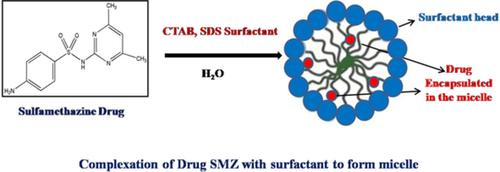当前位置:
X-MOL 学术
›
J. Surfactants Deterg.
›
论文详情
Our official English website, www.x-mol.net, welcomes your
feedback! (Note: you will need to create a separate account there.)
In vitro solubilization of antibiotic drug sulfamethazine: An investigation on drug–micelle aggregate formation by spectroscopic and scattering techniques
Journal of Surfactants and Detergents ( IF 1.6 ) Pub Date : 2021-12-14 , DOI: 10.1002/jsde.12569 Mavani A 1 , Aben Ovung 1 , Soching Luikham 1 , Debes Ray 2 , Vinod K. Aswal 2 , Sabyasachi Chatterjee 3 , Jhimli Bhattacharyya 1
Journal of Surfactants and Detergents ( IF 1.6 ) Pub Date : 2021-12-14 , DOI: 10.1002/jsde.12569 Mavani A 1 , Aben Ovung 1 , Soching Luikham 1 , Debes Ray 2 , Vinod K. Aswal 2 , Sabyasachi Chatterjee 3 , Jhimli Bhattacharyya 1
Affiliation

|
Micellar solubilization has been used extensively for the dissolution of sparingly soluble drugs for effective drug delivery. Apart from improving the solubility and bioavailability, micelles can help reduce toxicity and improve permeability in the system. In this article, solubilization of a well-known antibiotic, sulfamethazine (SMZ) upon micellization, is studied by employing various spectroscopic and scattering techniques like, ultraviolet–visible, fluorescence, small angle neutron scattering (SANS), and zeta potential (ZP) studies. The size(s) and charge(s) of the micelles were monitored by SANS and ZP. A positively charged/cationic surfactant, cetyl trimethyl ammonium bromide (CTAB) and a negatively charged/anionic surfactant, sodium dodecyl sulfate (SDS) are used for micelle formation. Regardless of the surfactant type, the solubility of SMZ increases linearly with the increase in the surfactant concentration, as a result of association between the drug and micelles. However, the solubility of SMZ is found to be better with CTAB than SDS. Upon interaction with SMZ, we observed that the critical micelle concentration of CTAB occurred at a lower concentration than that of SDS surfactant. As fitted in the ellipsoidal core–shell model, SANS results also show the formation of charged micelles. This comparative study can help us to select an appropriate medium for SMZ solubilization to improve selective drug delivery in biomedical applications.
中文翻译:

抗生素药物磺胺二甲嘧啶的体外增溶作用:通过光谱和散射技术研究药物-胶束聚集体的形成
胶束增溶已广泛用于溶解难溶性药物以实现有效的药物递送。除了提高溶解度和生物利用度外,胶束还可以帮助降低毒性并提高系统的渗透性。在本文中,通过采用各种光谱和散射技术,如紫外-可见光、荧光、小角中子散射 (SANS) 和 zeta 电位 (ZP),研究了众所周知的抗生素磺胺二甲嘧啶 (SMZ) 在胶束化时的增溶作用学习。胶束的大小和电荷由 SANS 和 ZP 监测。带正电荷/阳离子表面活性剂十六烷基三甲基溴化铵 (CTAB) 和带负电荷/阴离子表面活性剂十二烷基硫酸钠 (SDS) 用于胶束形成。无论表面活性剂类型如何,由于药物和胶束之间的结合,SMZ 的溶解度随着表面活性剂浓度的增加而线性增加。然而,发现 SMZ 的溶解度与 CTAB 相比优于 SDS。在与 SMZ 相互作用后,我们观察到 CTAB 的临界胶束浓度低于 SDS 表面活性剂的浓度。正如在椭圆形核壳模型中拟合的那样,SANS 结果也显示了带电胶束的形成。这项比较研究可以帮助我们为 SMZ 增溶选择合适的介质,以改善生物医学应用中的选择性药物递送。我们观察到 CTAB 的临界胶束浓度低于 SDS 表面活性剂的浓度。正如在椭圆形核壳模型中拟合的那样,SANS 结果也显示了带电胶束的形成。这项比较研究可以帮助我们为 SMZ 增溶选择合适的介质,以改善生物医学应用中的选择性药物递送。我们观察到 CTAB 的临界胶束浓度低于 SDS 表面活性剂的浓度。正如在椭圆形核壳模型中拟合的那样,SANS 结果也显示了带电胶束的形成。这项比较研究可以帮助我们为 SMZ 增溶选择合适的介质,以改善生物医学应用中的选择性药物递送。
更新日期:2021-12-14
中文翻译:

抗生素药物磺胺二甲嘧啶的体外增溶作用:通过光谱和散射技术研究药物-胶束聚集体的形成
胶束增溶已广泛用于溶解难溶性药物以实现有效的药物递送。除了提高溶解度和生物利用度外,胶束还可以帮助降低毒性并提高系统的渗透性。在本文中,通过采用各种光谱和散射技术,如紫外-可见光、荧光、小角中子散射 (SANS) 和 zeta 电位 (ZP),研究了众所周知的抗生素磺胺二甲嘧啶 (SMZ) 在胶束化时的增溶作用学习。胶束的大小和电荷由 SANS 和 ZP 监测。带正电荷/阳离子表面活性剂十六烷基三甲基溴化铵 (CTAB) 和带负电荷/阴离子表面活性剂十二烷基硫酸钠 (SDS) 用于胶束形成。无论表面活性剂类型如何,由于药物和胶束之间的结合,SMZ 的溶解度随着表面活性剂浓度的增加而线性增加。然而,发现 SMZ 的溶解度与 CTAB 相比优于 SDS。在与 SMZ 相互作用后,我们观察到 CTAB 的临界胶束浓度低于 SDS 表面活性剂的浓度。正如在椭圆形核壳模型中拟合的那样,SANS 结果也显示了带电胶束的形成。这项比较研究可以帮助我们为 SMZ 增溶选择合适的介质,以改善生物医学应用中的选择性药物递送。我们观察到 CTAB 的临界胶束浓度低于 SDS 表面活性剂的浓度。正如在椭圆形核壳模型中拟合的那样,SANS 结果也显示了带电胶束的形成。这项比较研究可以帮助我们为 SMZ 增溶选择合适的介质,以改善生物医学应用中的选择性药物递送。我们观察到 CTAB 的临界胶束浓度低于 SDS 表面活性剂的浓度。正如在椭圆形核壳模型中拟合的那样,SANS 结果也显示了带电胶束的形成。这项比较研究可以帮助我们为 SMZ 增溶选择合适的介质,以改善生物医学应用中的选择性药物递送。











































 京公网安备 11010802027423号
京公网安备 11010802027423号